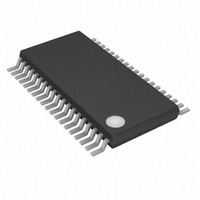MAX3209EEUU+T Maxim Integrated Products, MAX3209EEUU+T Datasheet - Page 5

MAX3209EEUU+T
Manufacturer Part Number
MAX3209EEUU+T
Description
IC RS-232 DUAL SRL 38TSSOP
Manufacturer
Maxim Integrated Products
Type
Transceiverr
Datasheet
1.MAX3209ECUU.pdf
(12 pages)
Specifications of MAX3209EEUU+T
Number Of Drivers/receivers
6/10
Protocol
RS232
Voltage - Supply
10.8 V ~ 13.2 V
Mounting Type
Surface Mount
Package / Case
38-TSSOP
Lead Free Status / RoHS Status
Lead free / RoHS Compliant
As with all Maxim devices, ESD-protection structures
are incorporated on all pins to protect against electro-
static discharges (ESD) encountered during handling
and assembly. The MAX3209E driver outputs and
receiver inputs have extra protection against static
electricity found in normal operation. Maxim’s engi-
neers developed state-of-the-art structures to protect
these pins against ±15kV ESD, without damage. After
an ESD event, the MAX3209E continues working without
latchup.
ESD protection can be tested in several ways. The
transmitter outputs and receiver inputs are character-
ized for protection to the following:
1) ±15kV using the Human Body Model
2) ±8kV using the Contact-Discharge Method specified
3) ±15kV using the Air-Gap Method specified in
ESD performance depends on a number of conditions.
Contact Maxim for a reliability report that documents
test setup, methodology, and results.
Figure 2a shows the Human Body Model, and Figure
2b shows the current waveform it generates when dis-
charged into a low impedance. This model consists of
with Low-Power Standby for Motherboards/Desktops
6, 7, 8, 12, 13,
25, 26, 27, 31,
20–24, 34–38
1–5, 15–19
in IEC 1000-4-2 (formerly IEC 801-2)
IEC 1000-4-2 (formerly IEC 801-2)
TSSOP
±15kV ESD-Protected, 12V, Dual RS-232 Serial Port
32, 33
14
10
11
28
29
30
—
9
PIN
1, 2, 3, 7, 8, 9
22, 24, 28, 30
_______________________________________________________________________________________
11–15, 36–40
16–20, 31–35
10, 21
QFN
25
26
27
Detailed Description
4
5
6
±15kV ESD Protection
ESD Test Conditions
R_OUT
T_OUT
NAME
V
Human Body Model
GND
T_IN
V DD
R_IN
N.C.
STBY
C+
C-
V-
TTL/CMOS Receiver Outputs
TTL/CMOS Transmitter Inputs
Standby Power Supply for R5 and R10
+12V Single-Supply Voltage
Positive Terminal of the Inverting Charge-Pump Capacitor
RS-232 Receiver Inputs
RS-232 Transmitter Outputs
Ground (for QFN package, connect the exposed pad and corner tabs to GND)
Negative Terminal of the Inverting Charge-Pump Capacitor
-12V Generated by the Inverting Charge Pump
No Connection. Not internally connected.
a 100pF capacitor charged to the ESD voltage of inter-
est, which is then discharged into the device through a
1.5kΩ resistor.
Since January 1996, all equipment manufactured
and/or sold in the European community has been
required to meet the stringent IEC 1000-4-2 specifica-
tion. The IEC 1000-4-2 standard covers ESD testing
and performance of finished equipment; it does not
specifically refer to integrated circuits. The MAX3209E
helps you design equipment that meets Level 4 (the
highest level) of IEC 1000-4-2, without additional ESD-
protection components.
The main difference between tests done using the
Human Body Model and IEC 1000-4-2 is higher peak
current in IEC 1000-4-2. Because series resistance is
lower in the IEC 1000-4-2 ESD test model (Figure 3a), the
ESD withstand voltage measured to this standard is gen-
erally lower than that measured using the Human Body
Model. Figure 3b shows the current waveform for the
±8kV IEC 1000-4-2 Level 4 ESD Contact-Discharge test.
The Air-Gap test involves approaching the device with a
charge probe. The Contact-Discharge method connects
the probe to the device before the probe is energized.
The Machine Model for ESD testing uses a 200pF stor-
age capacitor and zero-discharge resistance. It mimics
the stress caused by handling during manufacturing
and assembly. Of course, all pins (not just RS-232
FUNCTION
Pin Description
Machine Model
IEC 1000-4-2
5












